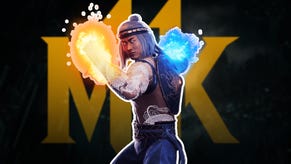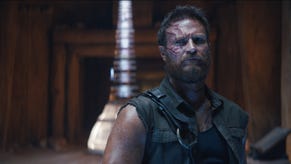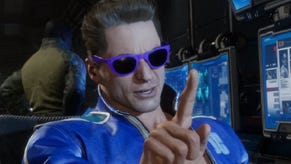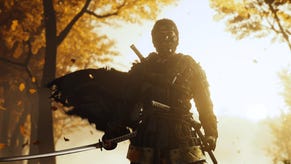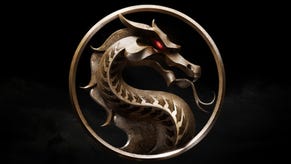The myth and magic behind the new Mortal Kombat 11 characters
Grisly brawler Mortal Kombat has Chinese sorcerers, evil lizard people, and Jean-Claude Van Damme spoofs. Like all fighting games, it draws from movie action tropes, a world of smug mercenaries and sassy ninja gals.
However, because of Mortal Kombat’s unique setting, fighters include gods and monsters. Sure, the fate of the universe is still getting decided with fisticuffs and hearty evisceration in select locations, but the Elder Gods (and much worse) roam free.
The latest instalment catches series mainstay Raiden (conceived via Japanese and Chinese mythology plus a John Carpenter villain) poking around the cosmos. It also adds a few new characters in the mythic vein.
Take for example, new blue-eyed beefy boy Geras: an entity who can warp the literal sands of time, and who sometimes sports an ancient metal fist. A man who delivers phrases like “I am eternally alone” with rugged self-confidence.
“You bluff poorly, Sonya Blade”, he says, during a moment of immortal clarity. He’s wise, by Mortal Kombat standards.
Geras is named after the little known Greek god of aging. Unfortunately, the time powers and eternal wisdom are where the similarities end, as the original deity presents as a shriveled old man.
Within the dark tomes of the Mortal Kombat universe, Geras serves as a loyal servant to 11’s biggest bad Kronika. Like Geras, she can manipulate space and time.
Her name stems from mighty Greek Titan King Cronus - who is often interpreted as time itself. Scared he would be overthrown, Cronus devoured his own children, spare one: Zeus, king of the gods.
Geras’ link to mythic references in the Mortal Kombat universe is similar to scary insect lady fighter D’vorah’s - a name originating from the Hebrew word for bee. The game draws on the themes associated with the moniker, and then churns them through the nightmare trash filter of the Mortal Kombat universe.
Next up, we have new playable character Kollector. Although he looks like a cross between a Skyrim vampire lord and a demented tax man, he has both the mythic and occult touch. He draws upon an unholy mix of Hindu goddess Kali, and Biblical bad boy Mammon.
Game-wise, Kollector acquires souls and shiny coin for Shao Kahn the Konqueror - a Mortal Kombat 11 antagonist and the bright mind behind the Flesh Pits.
“My wallet is not skinny,” says bravado action man Johnny Cage at the start of a battle. Undeterred, Kollector replies: “Hand it over.” He has a host of cartoonishly evil quips, including “my slavers need breeding stock,” among other delights.
Kollector’s multitude of limbs and blueness are very similar to Hindu goddess Kali, and like her, he has an affinity for collecting body parts. Kali famously sports a garland made of human heads. Nice.
In fatality move For The Kollection, he removes his opponent’s heart and head, and stows them away in his satchel. In one intro, he is seen picking a shiny ring off of a dismembered arm. However, as an embodiment of destruction and impermanence, Kali is above collecting cheap trinkets. So Kollector’s Hindu links only stretch so far as looks and bloodlust.
As such, his rapacious attitude reminds me of dark entity Mammon. To some, Mammon is the embodiment of worldliness, to others, he is the lord of greed.
Sometimes, Mammon is depicted as a prince of hell or a literal demon. In John Milton’s Paradise Lost, fallen angel Mammon is too busy scraping gold off the ground to fight God. The New Testament in the bible quotes: “Ye cannot serve both God and Mammon.” The name itself springs from the Aramaic māmōn, which means riches.
So ubiquitous is Mammon, that its incarnations throughout the ages vary from red-skinned archdemons to crooked old men. As such, He is only recognisable by excess, and his need to flaunt and horde - at any cost.
In the spirit of Mammon, Kollector dons bright jewels and fancy collars. In the spirit of capitalism, Kollector even dabbles in loan sharking. He also carries around a bottomless satchel containing a stash of interdimensional riches. Most significantly: Kollector loves that sweet, sweet tribute. No doubt Mammon would be delighted to have Kollector on the team.
Back to the ancient gods vein, there’s Elder Goddess Cetrion, who commands the four elements - like the Last Avatar. Earth definitely seems to be her mainstay choice though, as she is particularly fond of hurling borders.
Although she veers between smiling at butterflies and crushing people into smithereens with cosmic lasers, Cetrion could have some connections with a fertility goddess. Namely, Roman deity Ceres - the counterpart to ancient Greek agriculture goddess Demeter.
There is definitely a hint of the haunted harvest to Cetrion. Greenery springs up to her feet. She quips a lot about balance. She has a particular fondness for Eldritch stones. One of her moves involves pinning an opponent to a tree with jagged rocks, which has the look of a cursed corn mother form of tribute.
Demeter watches over life, death and an awful lot in between. Her daughter, Persephone, became queen of the underworld. I won’t go too much into Cetrion’s plotline, but let's just say that “Mother” is a huge theme throughout her story.
Then again, there are no records of Demeter expanding into space, and vomiting a ten billion foot death beam - as seen in one of Cetrion’s finishers. That said, I think Cetrion draws from the Earth Mother more than she does the old gnarly tree druid trope.
The links behind these characters: time, avarice, pointy rocks, glimmer out beneath the pulp of the Mortal Kombat Realms. Among its action heroes and mysterious ninjas there’s all kinds of mythic influences spanning the entire world. Jumbled together and tinged with ultra-violence, they represent yet more ways mythology continues to subtly shape culture - and blood-soaked fatalities.







